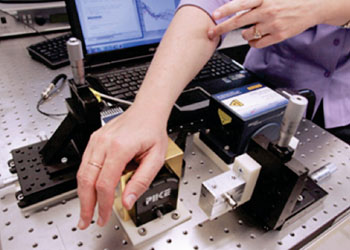Noninvasive Glucose Sensing Uses Mid-Infrared Light
By LabMedica International staff writers
Posted on 02 Sep 2014
A laser has been developed to measure people's blood sugar, and the technique could allow diabetics to check their condition without pricking themselves to draw blood. Posted on 02 Sep 2014
Bioengineers at the Princeton University (NJ, USA) utilized a hollow-core fiber based optical setup for light delivery and collection along with a broadly tunable quantum cascade laser to obtain spectra from human subjects and use standard chemometric techniques. In vivo glucose sensing using mid-infrared (IR) spectra was conducted with three healthy human subjects starting on an empty stomach with glucose levels were typically around 80 mg/dL at this time to obtain spectra for their low levels.

Image: The new monitor uses a laser to read blood sugar levels. The laser is directed at the person\'s palm, passes through skin cells and is partially absorbed by sugar molecules, allowing scientists to calculate the level of blood sugar (Photo courtesy of Princeton University, Engineering School).
Light from a pulsed external cavity Quantum Cascade Laser (Daylight Solutions Inc.; San Diego, CA, USA) with a tuning range between 8–10 μm was focused into a 500 μm diameter hollow-core fiber (Opto-Knowledge Systems, Inc.; Torrance, CA, USA) responsible for delivering light onto a region of the human palm between the thumb and index finger. Backscattered light from the skin was collected using a bundle of six fibers, identical in composition and size to the delivery fiber, arranged in a circular fashion around the delivery fiber and coupled directly to a commercial liquid nitrogen cooled mercury cadmium telluride (MCT) detector.
Numerical values for a subject’s blood glucose concentration level were obtained using a commercial electrochemical meter (OneTouch; High Wycombe, UK) prior to the optical study. Up to ten spectra were taken for each concentration, with a single spectral scan taking roughly 20 seconds; upon conclusion of such a set, the subject once again obtained a reading from the commercial meter to ascertain the stability of blood glucose levels throughout the elapsed time period.
The mid-IR spectra obtained in vivo from human skin yield clinically accurate predictions for blood glucose levels for concentrations between 75–160 mg/dL using both partial least-squares regression (PLSR) and derivative spectroscopy techniques with given calibration sets yielded average errors only 2% more than those from a commercial electrochemical meter. The glucose absorption features in mid-IR skin visibly change with respect to increasing concentration, as absorption minima increase in depth and width. The authors concluded that this application of mid-IR light to noninvasive in vivo glucose sensing yields a robust and clinically accurate system that transcends boundaries set in the past which limited the scope of mid-IR in vivo applications.
Claire Gmachl, PhD, a professor of Electrical Engineering and senior author of the study, said, “With this work we hope to improve the lives of many diabetes sufferers who depend on frequent blood glucose monitoring. Because the quantum cascade laser can be designed to emit light across a very wide wavelength range, its usability is not just for glucose detection, but could conceivably be used for other medical sensing and monitoring applications.” The scientists are working on ways make the device much smaller. The study was published on July 1, 2014, in the journal Biomedical Optics Express.
Related Links:
Princeton University
Daylight Solutions
Opto-Knowledge Systems













